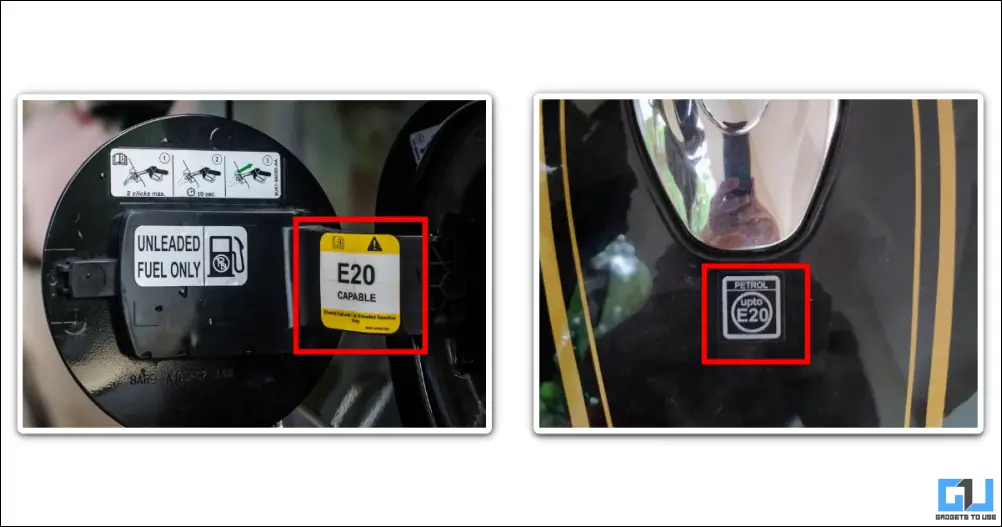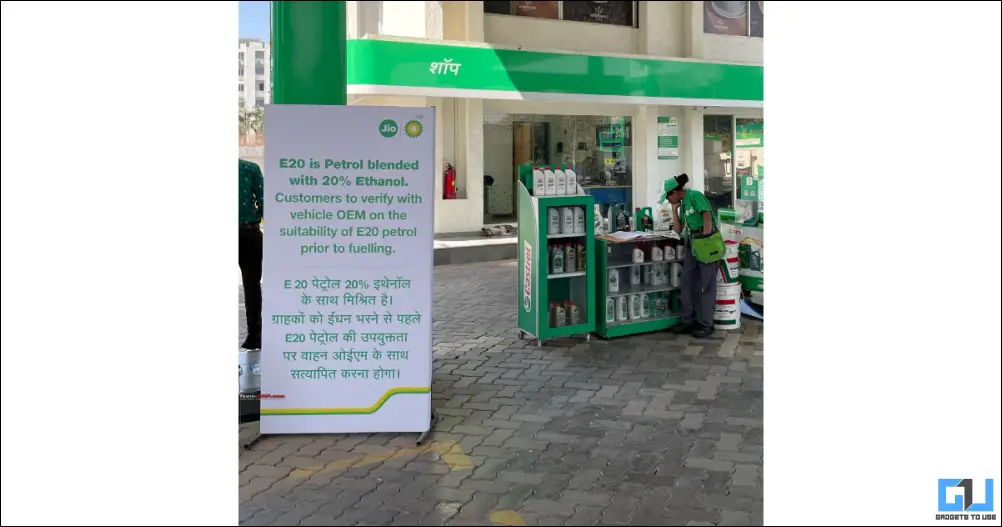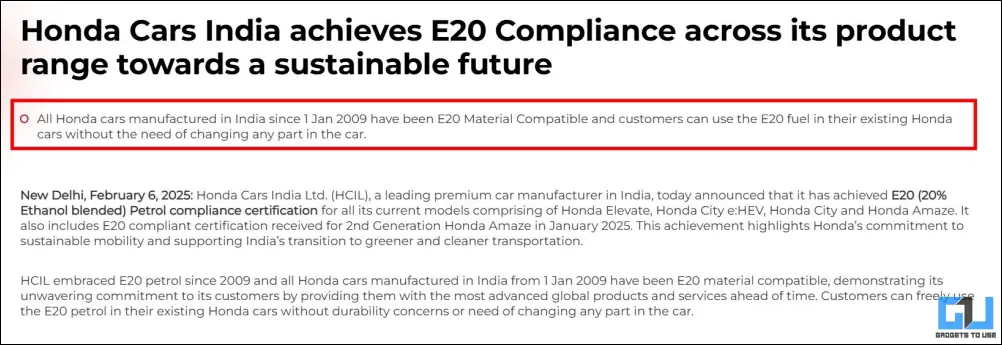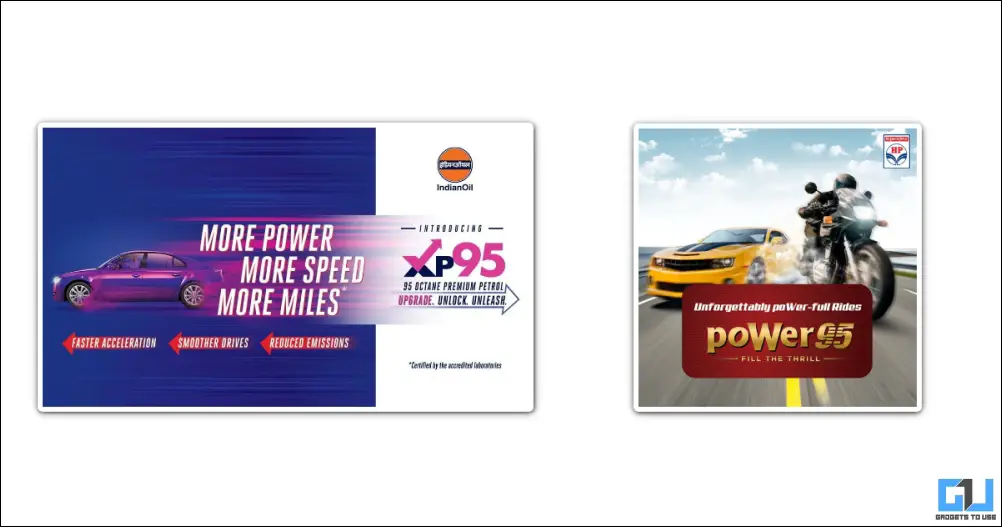- You can also take your car or bike to the nearest authorized service centre, which can help you determine E20 compatibility of your vehicle by checking the engine number, and other details.
- The easiest way to confirm whether your vehicle can run on E20 petrol is to look for the E20 sticker.
- You can also refer to the owner’s manual of your vehicle, which will specifically mention what type of fuel is best suited for your car or bike.
After poor road conditions and high toll taxes, vehicle owners in India now face a new challenge: the new E20 petrol standard. The Government of India has rolled out E20 fuel all across the country, where petrol is mixed with 20% ethanol to reduce emissions and crude oil imports. However, many owners have started to complain that the new fuel has reduced the mileage and performance of their vehicles. There are also concerns that older vehicles may face permanent engine damage if used with E20 petrol.
We have conducted an in-depth research study of the E20 fuel situation in India. Our GadgetsToUse team has also gathered insights from industry expert Gagan Chaudhary to understand the effectiveness of alternative high-octane fuels such as Power95, XP95, or XP100. Let’s bust some myths related to E20 petrol and understand whether your vehicle is suited for E20 fuel.

Does E20 Petrol Damage the Engine?
The short answer is yes, E20 petrol can damage your engine, especially if your vehicle is not compatible with it. The higher concentration of ethanol in E20 fuels can create corrosion in your fuel tank, fuel injection system, firing cylinder, piston rings, and other components. This is because ethanol absorbs water, leaving behind a residue of corrosive materials, which will eventually damage your engine over the long run.
This damage will not happen overnight. It’s a slow process, and depending on how you use your vehicle, it can take anywhere from 12 months to several years before your engine starts showing problems. If you have an old car or bike that was not designed for E20 fuel, the effects will be faster.
If you purchased your vehicle after April 2023, then you most likely have an E20-compatible engine. Automakers have made several changes to the latest engine and fuel systems to reduce and minimize the harmful effects of ethanol. But remember that just because your car or bike is E20 compatible, it does not mean that you are safe from the problem. The chemical composition of ethanol is such that it will kill your engine faster, compared to E10 or fuels with better purity.

Don’t just take our word on this. TVS Motors, which is the third-largest 2-wheeler company in India, also says the same on its official website. E20 petrol is more corrosive than regular fuel, and it can damage your vehicle.
It is worth noting that damage caused to your engine, fuel system, or other components is not covered under warranty. You will have to pay for the repairs from your own pocket.
How to check if your car or bike is E20 petrol compatible?
The easiest way to confirm whether your vehicle can run on E20 petrol is to look for the E20 sticker. This is usually placed on the fuel tank of bikes and on the fuel tank cap of cars. You can also refer to the owner’s manual of your vehicle, which will specifically mention what type of fuel is best suited for your car or bike. If none of these have the mention of E20, then your vehicle is not designed to run on E20 petrol.

You can also take your car or bike to the nearest authorized service centre, which can help you determine E20 compatibility of your vehicle by checking the engine number, and other details.
Some petrol pumps in India have already displayed banners that they have shifted to E20 petrol. They are also warning vehicle owners to check the compatibility of their cars and bikes with E20 fuels.

Are all BS-VI vehicles compatible with E20 petrol?
This is the biggest misconception happening around this topic. The direct answer is NO. BS-VI is an emission norm that puts restrictions on the output of harmful gases from your vehicle’s exhaust. Whereas E20 petrol is a type of fuel, which signifies the amount of ethanol blended in the petrol. BS-VI (including BS-VI Phase 2) has nothing to do with E20 compatibility.
Just because you have a BS6 car or bike, does not mean that it can run on E20 petrol. You should specifically see and check whether your vehicle model can run on E20 fuel, by looking for the sticker or in the user manual.
The only exception here is Honda, as the company made all of its cars in India compatible with E20 fuel way back in 2009. So, if you have purchased a Honda car after 2009 in India, your vehicle is ready to run on E20 petrol. You can also find BS3 and BS4 cars from Honda compatible with E20 fuels.

Note that this only applies to Honda cars, and NOT Honda two-wheelers. So if you have an Activa, Shine, Unicorn, Hornet, or any other Honda two-wheeler, you should check for E20 fuel compatibility manually.
Should You Use Power95, XP95, or XP100 fuel instead of E20 petrol?
Power95 by Hindustan Petroleum (HP), and XP95, XP100 by Indian Oil are high-octane fuels, designed for better power output. However, according to automobile expert Gagan Chaudhary, “The Government of India has not specified whether high-octane fuels have lower ethanol content or not”.
Many people have claimed that XP95 and other types of high-octane fuel have a lower ethanol blend, which makes them purer. This is just a myth, and there is no factual information available on the same. There is no confirmation on this from the Government of India, the Oil Ministry, the Transport Ministry, or even any of the fuel distributors like Bharat Petroleum, Hindustan Petroleum, Indian Oil, and others.

Fuels like XP95 or XP100 will offer better power delivery because of higher octane, but even these fuels have some amount of ethanol mixed in. Since there is no official data on the exact percentage of ethanol blending in these higher octane fuels, we cannot determine whether using these expensive petrols can actually save our engines from ethanol damage.
Can you run your older car with E20 petrol?
Even if you have an older car or bike, it can still run on E20 petrol. However, you will notice a significant drop in mileage, reduced power output, and a higher risk of damaging your engine.
Unfortunately, the Government of India has completely shifted to E20 petrol, leaving us with no choice. Western countries offer multiple grades of fuel, where you have the option to choose between E5, E10, or E20 petrol, depending on the type of your vehicle. However, you will now get only E20 petrol in India, so even if you have an incompatible vehicle, you are forced to use it.
Does E20 petrol reduce mileage?
Yes, E20 petrol offers lesser mileage, as the overall power output of E20 fuel is lower compared to E10 or E5 petrol. So when you shift towards E20, you will notice reduced mileage and power output from your car or bike, even if it is E20 compatible.
Another misconception of E20 petrol is related to pollution. Although E20 fuel emits fewer harmful gases, the effective pollution is the same as regular fuel. This is because of the lower mileage. Let’s understand this with an example.
Earlier, if you had to go from point A to point B, you would burn, let’s say, 1 litre of petrol. Since E20 fuels have reduced mileage, you will have to burn more fuel to cover the same distance. Consuming more fuel means you are emitting gases in higher quantities, increasing the level of pollution. You also have to spend more on fuel, making the travel more expensive.
Sustainability of E20 Petrol
The primary objective of E20 petrol was to control emissions and also reduce crude oil imports. However, we have already discussed how E20 petrol is not helping us much in controlling pollution. Coming to the crude oil imports, despite mixing 20% ethanol, the prices of petrol in India have not reduced at all.
Petrol prices in India touched Rs 100 per litre in 2022, when crude oil prices were at an all-time high. However, global crude oil rates have reduced from $112 to just $70 per barrel over the last three years. And when we consider the 20% addition of locally produced ethanol, the prices of petrol should have reduced in India, but we have not seen any discounts in fuel over the last three years.

The Indian rupee depreciated by 14% from Rs 76 to Rs 87 per US Dollar in the same period. Compared to the 50% reduction in global crude oil prices and the ethanol blending, we should have experienced at least a 20% reduction in petrol prices, but that has not happened.
Studies show that it can take up to 3000 litres of water to produce just 1 litre of ethanol. This is because the majority of ethanol produced in India comes from sugarcane, which requires a high amount of water to cultivate. India is also facing a potential water crisis as the water table of the country is currently at an alarming low level.
All these factors question the sustainability of ethanol blending in petrol. Is it really worth shifting to E20 petrol? Looking at the data, it feels like there are more disadvantages than advantages. The fuel prices have not changed, engines are at risk of getting damaged, there is a high water requirement in ethanol production, and all other factors are stacked against the E20 petrol standard.
E20 Petrol: Decoded
It feels like only the Government and automakers will benefit from the switch to E20 petrol. With reduced mileage, you will be spending more on fuel, which will contribute to higher tax collection. The government is also not passing the discounts of ethanol blending to the citizens, which also works in their favour.
Since the new fuel also damages the engine, automakers may also earn significant money in engine repairs, which are known to be pricey. You may also be forced to buy a new vehicle faster. Some people may also start looking towards electric vehicles, which ultimately benefits both the government and car/bike companies.
As a common man, you are currently forced to use E20 petrol, even if your vehicle does not support it. There’s nothing you can do to protect your car or bike. We can only request the government to provide options to have E10 fuels, so that users with older vehicles can use their cars and bikes without worrying about damage from E20 fuels.
You may also like to read:
Have any questions related to our how-to guides, or anything in the world of technology? Check out our new GadgetsToUse AI Chatbot for free, powered by ChatGPT.
You can also follow us for instant tech news at Google News or for tips and tricks, smartphones & gadgets reviews, join the GadgetsToUse Telegram Group, or subscribe to the GadgetsToUse Youtube Channel for the latest review videos.
Was this article helpful?
YesNo


